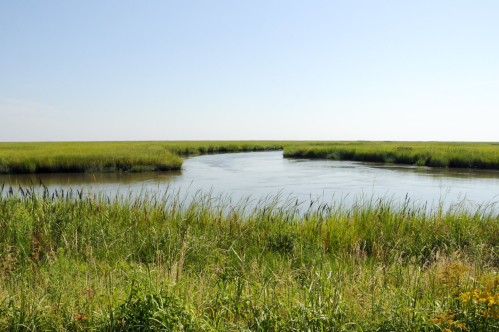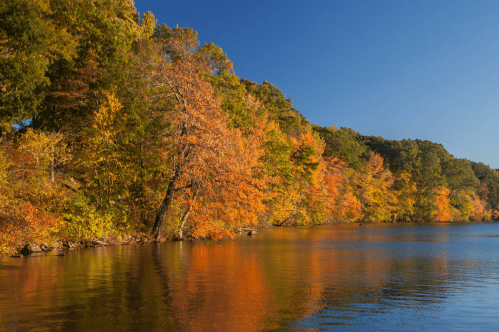The Great Depression began in October 1929 with the largest stock market crash America had ever seen. By 1933, as many as 13 to 15 million Americans were without work and almost half of the nation's banks had gone under. Fortunately, Virginia fared better than many states thanks to factors like agricultural diversity, limited manufacturing reliance, and diverse commerce. Likewise, a large government and military presence in Washington and Norfolk brought in much-needed government funds.
However, in the end, the Great Depression in Virginia spared no one and the residents saw their fair share of hard times. Some of the hardest hit were in rural areas, of which Virginia had many. The following historic photos of Virginia show many of those areas, as well as a few of the equally devastated urban areas. Collectively, they remind us of just how much we have to be thankful for — even during trying times.
1. Farmers cradling wheat in Montgomery County near Christiansburg, 1939.
During the Great Depression in Virginia, farmers were forced to exercise extreme frugality. Very little equipment could be purchased or even repaired, requiring time and labor-intensive practices for farmers and migrant workers.
2. A young Nelson County boy sits on the porch of a general store in Roseland, 1938.
Some Virginia businesses fared better than those in other states during the depression because much of Virginia’s production was consumer-based, meaning we made things even people in poverty "couldn’t live without." General stores like this one would have sold these "necessaries," which in the 1930s, included food, clothing, and cigarettes.
3. Young farmers walk their cow along a rural road in Allegheny County, 1939.
Many young people left their family farms for cities in the earlier years of the depression, only to return hoping to find greater security than what they found in urban areas.
4. Young farm boys cradling wheat on a farm near Sperryville in Rappahannock County, 1936.
Because mechanical equipment was scarce, these farm boys would pair up to harvest wheat. One would "mow" with a cradle scythe and the other would follow to bind the wheat by hand. Photographer Dorothea Lange interviewed the boys who confessed that they had never even heard of a combine harvester. "Sure would like to see that," said one of the boys. Their father had always used a sickle, or reap hook, to cut the wheat.
5. Families in Richmond stand outside their homes, 1938.
The economic scarcity of the depression hit the African American community especially hard, as they were often the last to be hired and first to be let go. These houses in Richmond offered 3 rooms each for $12 a month.
6. Bargain tombstones in Lexington, 1939.
Even as the depression was coming to a close, money remained scarce and overproduction was often a problem. An "unnecessary" item like a tombstone would not be high on the priority list for many during this time, hence, the great deals.
7. The Chapel Tower at Hampton Institute, 1936.
Founded as the Hampton Normal and Agricultural Institute in 1868 to train newly emancipated black youth, Hampton Institute saw many distinguished graduates over the years, including the renowned educator Booker T. Washington. But like many colleges during the depression, the school faced crippling financial deficits. Enrollment declined and much of the staff was dismissed. By 1940, the administration had to discontinue the Library School and hand over the Nursing School to a local hospital.
8. A craftsman at the Chopawamsic Recreational Project makes “shakes” (hand-made, wooden shingles) in Stafford County, 1936.
During the Great Depression in Virginia, the federal government instituted a program to repurpose unsuccessful or idle farmland and forests into recreation grounds. Using local families as labor, the program was a form of federal aid, providing steady work and training. Chopawamsic, an area near Dumfries in northeastern Virginia, became a prime example of the program.
9. A laborer on the Chopawamsic Recreational Project, 1936.
About 150 families lived in the areas selected for the Chopawamsic Project, but only about forty heads of households held steady jobs and many of the families were on government relief. Some families were relocated to more successful farmlands and given agricultural training. Others lived in government-supplied camps where children were instructed in skills like woodworking, basketry, botany, geology, and ornithology. Pediatricians and dietitians provided training in childcare and nutrition for young mothers, while men were used as labor to build and restore cabins and recreational structures throughout the new park system.
10. Locals gather on the porch of the post office in the small town of Nethers in Madison County, 1935.
When the Shenandoah National Park was formed during the depression, more than 500 families who had lived on the 193,000 acres of land used for the park were displaced, or "resettled." Much of the population lived in Madison County in areas like Nethers, Old Rag, Nicholson Hollow, Corbin Hollow, and Weakley Hollow. Many of these people were thought to be primitive folk who existed outside the realm of a larger society, therefore the act was considered humanitarian by many.
11. Russ Nicholson was one of the farmers who was displaced. When this photo was taken in 1935, he was grandfather to all of the Nicholson children living in Nicholson Hollow.
Because of the isolation of the people living in the mountains at the time, many of the married couples were first cousins.
12. A mountain farmer lays apples out to dry on the roof of his cabin in Nicholson Hollow near Old Rag Mountain in Madison County, 1935.
Many of the people in the Blue Ridge Mountains at this time were farmers who relied on crops like apples for their own consumption, but also for trade, a fact made more difficult by the depression.
13. Fannie Corbin with one of her daughters in Corbin Hollow. Fannie was the mother of 22 children at the time of this photo in 1935.
When Corbin Hollow was first examined in 1932 by the Washington Child Research Center, it was discovered that of the 6 families living there, all of the adults were cousins, each with the name Nicholson or Corbin. The 2 families had descended from the same post-Revolutionary War settlers and had been intermarrying ever since.
14. Inside a Corbin Hollow home, 1935.
The Corbin Hollow community was formed alongside the Skyland Resort in 1886. The inhabitants of Corbin Hollow relied heavily on the resort for labor and craft sales. When the depression hit and tourism dried up, their meager existence became that much more sparse.
15. Mrs. Eddie Nicholson would frequently go to the Skyland Resort to beg from the few remaining tourists, 1935.
16. A mountain farmer sells apples and cider by the side of Lee Highway in Rockingham County, 1935.
Even before the depression, rural farmers in Rockingham County relied heavily on apples for income.
17. The Dodson family at home in the small community of Old Rag in Page County before they were relocated, 1935.
The Dodson Family had nine children. It was not uncommon for families to be large in these rural communities, making care and feeding that much more difficult during hard economic times.
18. Mrs. Dodson with three of her nine children, 1935.
19. Milton Puryeur of Dennison in Halifax County kills hogs for a neighboring landowner, 1939.
While the late 1930s saw a return of economic stability to Virginia, for many, the damage was already done. Milton Puryeur owned five acres just south of South Boston and had once grown tobacco and cotton but was reduced to subsistence farming during the depression. In this photo, he burns old shoes and leather to keep flies away from the slaughtered hogs.
20. A woman huddles in the doorway of a decrepit storefront in Newport News, 1937.
Like all big cities, Newport News suffered during the depression, as evidenced by the condition of this shop. Even the wealthy and prestigious families were not safe. In 1930, millionaire-sportsman Horace E. Dodge Jr., of the "Dodge Motors" family, opened the world's largest and most modern motorboat plant in Newport News, but couldn’t survive the economic times and closed in 1936.
21. Produce piles up outside of the Barter Theatre in Abingdon as patrons “barter” their way in to see stage productions, 1930s.
When Robert Porterfield, an out-of-work New York actor and Saltville native, returned to Southwest Virginia during the Great Depression, he began a venture called the Barter Theatre. The doors opened in 1933, and according to the theatre’s website, Porterfield operated under the mantra that "With vegetables you cannot sell, you can buy a good laugh." Admission was 40 cents or the equivalent in produce, livestock or dairy. Seats filled with continuing regularity as the idea of "ham for Hamlet" caught on. Today, the Barter Theatre is one of Virginia’s premier performing arts’ venues.
22. John D. Ferguson and his son riding in their wagon in Pittsylvania County, 1939.
As times improved, farmers, once again, were able to find markets for their goods. However, it would be a long time before many could afford to move away from manual and horse-driven labor as machinery was still expensive.
23. The McDonald’s farm near Fincastle in Botetourt County, 1934.
This farm, with its ramshackle appearance and missing siding, provides an example of the state of disrepair seen on many farms during the depression.
24. A handbill that was passed around in Herndon in 1936 announcing the auction of a family farm.
One of the reasons Virginia fared better than some states during the depression was our reliance on the agricultural economy. We offered diverse crops and a high level of subsistence farming, meaning that many people could "get by," if only barely. However, no one was immune to the economic devastation of the time and many families lost their farms.
25. A soldier keeping guard at the Tomb of the Unknown Soldier in Arlington National Cemetery, 1934.
If You Only Have One Day to Visit This Small Town in Maine, Here’s Everything You Absolutely Can’t Miss

If You Only Have One Day to Visit This Small Town in Massachusetts, Here’s Everything You Absolutely Can’t Miss

If You Only Have One Day to Visit This Small Town in Maryland, Here’s Everything You Absolutely Can’t Miss

And last but not least, even while the country was in turmoil, the faithful in Virginia stood their post.
These powerful images are poignant reminders of a time that many Virginians still remember, whether for themselves or through the stories of parents and grandparents. And they certainly drive home the fact that we have much to be grateful for, especially as we recognize that there are many who are still in need, even in Virginia.
Do you know much about the Great Depression? What are your thoughts on these historic photos of Virginia? We would love to hear any stories you might have to share. Please feel free to pass along your thoughts and stories in the comments below.
Subscribe to our newsletter
Get the latest updates and news
Thank you for subscribing!


































